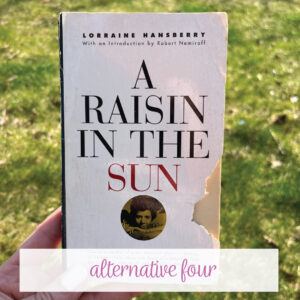Teachers look for alternatives to The Crucible for a variety of reasons. Here are some sound ones.
The Crucible is in American literature textbooks going back decades. High school language arts teachers can meet literature standards and often, we can meet informational text standards when we pair the play with information about McCarthyism and the Salem witch trials. Still, the text is several decades old, and modern students crave modern stories—and we teachers do too.

Why would teachers want alternatives to The Crucible?
Isn’t this play a classic?
I would argue that the play has merit and is probably a classic. Still, teachers share legitimate reasons for eliminating the play or for pairing the play with another text.
For one, the discussion of hanging can disturb students, and their mental health is a concern. The entire play hinges on the concept of hunting witches, and many female students draw parallels to their lives, again making for psychological unrest. As I write this post in 2024, the balance of mental health for students while meeting students has overwhelmed teachers.
Second, teachers argue that modern stories should replace a 70+ year-old story. (I don’t disagree!)
Finally, some classes dislike plays. To meet standards and to engage modern students, we ELA teachers are flexible. This play simply might not be the best choice for a group.
What teaching alternatives to The Crucible exist?
Many books, fiction and nonfiction, convey similar themes and address historical aspects of America that The Crucible provides. Language arts teachers can also pair one of these alongside excerpts of The Crucible and vice versa.

Alternative One: The Chocolate War by Robert Cormier
Cormier was one of the first young adult literature writers, and his books are still fresh. The Chocolate War covers a Catholic school fundraiser. The student organization involved with a crooked teacher exiles and tortures non-conforming students.
- Abuse of power.
- Beautiful language.
- Spread of lies and misinformation.
Main themes in Miller’s play deal with manipulation and harm. The Chocolate War does too.

Alternative Two: The Wave by Todd Strasser
The Wave is a bit hokey IMO, but classes read the book, enjoy the book, and understand the book. Plus, tons of interviews concerning the story make it real for students.
Strasser’s story is based on a real story. A teacher in California taught his students about Hitler and his manipulation of Germans. The students doubted that human nature would allow for that, so the teacher developed a program (the wave) and within days, students were blindly following a movement.
The story covers hysteria and the dangers of blindly following others, similar to The Crucible.

Alternative Three: Just Mercy by Bryan Stevenson
Just Mercy explains the failings of the American court system with Black people, specifically Black youth. Even if language arts teachers cannot teach the entire nonfiction book, an excerpt will work. Students will read this book, and they will be shocked and enthralled.
Since Just Mercy is nonfiction, you will meet different standards. The “witch hunts” that Stevenson details are heartbreaking and important to know, and for this book’s importance, it is a valid alternative.

Alternative Four: A Raisin in the Sun by Lorraine Hansberry
I have taught Hansberry’s play at two different schools and at both places, the story moved students. A Raisin in the Sun allows for lessons over redlining, the Harlem Renaissance, and American social structures among other topics.
Parallels from both plays include:
- Sexism.
- Harm from the government.
A Raisin in the Sun and The Crucible were both published during the 1950s, and Hansberry’s play is a great alternative. You can see in the above picture how loved my copy of the play is—this copy is several decades old, well-read.

Alternative Five: There, There by Tommy Orange
I recently finished There, There and want to share this book with all ELA teachers. Orange’s story can be used in several ways:
- To teach characterization. A dozen characters tell this story, and each one has unique features.
- To cover history. Similar to The Crucible, There, There covers the ramifications of government mistakes with devastating results.
- To read historical fiction. There, There is about the trauma and difficulties Native Americans face because of the government’s destructive relocation, Trail of Tears, residential schools, and more.
This book is most appropriate for juniors and seniors, another reason it is perfect to replace The Crucible.
What about Arthur Miller’s allegory?
Well, I’m not entirely attached to teaching classics. I do understand that English teachers have possibly built a concrete and strong unit plan. Plus, McCarthy era or red scare, mass hysteria, communism, and accusations of witchcraft nicely fit with what students learn in American history. Finally, the connections and discussions can be rich: Did John Proctor take advantage of Abigail Williams? In what ways does social media and the anonymity of the Internet encourage witch hunts? How has Hollywood portrayed Miller’s scrutiny of Joseph McCarthy and hypocrisy of Puritans?
I don’t have a deep commentary about teaching or not teaching The Crucible. Overall, I am not in love the main characters or my lessons on fear of communism. While I can’t offer much clarity about your decision with teaching The Crucible, these alternatives will provide similar opportunities for teaching stage directions, figurative language, and inferences, along with modern day comparisons concerning vengeance, frenzy, and evils.
Final thoughts about The Crucible.
Arthur Miller’s play is a classic but for a variety of reasons, language arts teachers seek alternatives to The Crucible. Personally, I enjoy the play, but teachers have sincere reservations concerning teaching it.
These alternatives help to meet a variety of literature standards and with a few well placed mentor sentences, can help to meet language standards as well.
All of the links to Amazon are affiliate links in which I might earn commission, at no cost to you. Please read my disclosures page for more information.

